前言
前面的我们使用的是一个表的操作,但我们实际的开发中不可能只使用一个表的…因此,本博文主要讲解关联映射
集合映射
需求分析:当用户购买商品,用户可能有多个地址。
数据库表
我们一般如下图一样设计数据库表,一般我们不会在User表设计多个列来保存地址的。因为每个用户的地址个数都不一的,会造成数据冗余
- 创建两张数据表,一张保存着用户的信息,一张保存着地址的信息。地址表使用外键来引用用户表
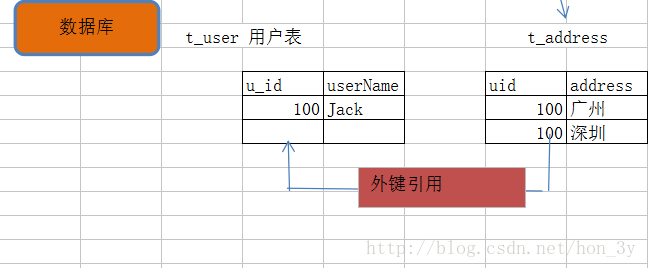
实体
由于地址只是使用String类型来保存着,那么我们直接使用一个User对象就可以了
1
2
3
4
5
6
7
8
| public class User {
private String id;
private String username;
private String password;
private Set<String> address;
|
映射文件
1
2
3
4
5
6
7
8
9
10
11
12
13
14
15
16
17
18
19
20
21
22
23
24
25
26
27
28
29
30
31
32
33
34
35
36
| <?xml version="1.0"?>
<!DOCTYPE hibernate-mapping PUBLIC
"-//Hibernate/Hibernate Mapping DTD 3.0//EN"
"http://www.hibernate.org/dtd/hibernate-mapping-3.0.dtd">
<hibernate-mapping package="zhongfucheng.domain">
<class name="User" table="user">
<id name="id" column="id" >
<generator class="native"/>
</id>
<property name="username" column="username"></property>
<property name="password" column="password"></property>
<set name="address" table="address">
<key column="user_id"></key>
<element column="addr" type="string"></element>
</set>
</class>
</hibernate-mapping>
|
测试:
1
2
3
4
5
6
7
8
9
10
11
12
13
14
15
16
17
18
19
20
21
22
23
24
25
26
27
28
29
30
31
32
33
34
35
36
37
38
39
40
41
42
43
44
45
46
47
| package zhongfucheng.domain;
import org.hibernate.SessionFactory;
import org.hibernate.Transaction;
import org.hibernate.cfg.Configuration;
import org.hibernate.classic.Session;
public class App {
public static void main(String[] args) {
User user = new User();
user.setUsername("123");
user.setPassword("1234");
user.getAddress().add("广州");
Configuration configuration = new Configuration();
configuration.configure().addClass(User.class);
SessionFactory factory = configuration.buildSessionFactory();
Session session = factory.openSession();
Transaction transaction = session.getTransaction();
transaction.begin();
session.save(user);
transaction.commit();
session.close();
}
}
|
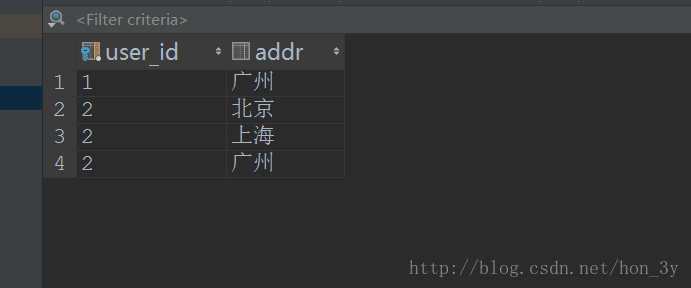
List集合映射配置
既然我们现在已经会了如何配置Set集合了,List集合又怎么配置呢??
想一下,List集合和Set集合有什么区别…List集合是有序的,因此要多配置一个列来维护数据的有序性!
1
2
3
4
5
6
7
| <list name="address" table="address">
<key column="user_id"></key>
<list-index column="indexNum"></list-index>
<element column="addr" type="string"></element>
</list>
|
Map集合映射配置
Map集合和Collection集合的区别就是键值对模型,那么在配置的时候多一个key即可!
1
2
3
4
5
| <map name="address" table="address">
<key column="user_id" ></key>
<map-key type="string" column="short"></map-key>
<element type="string" column="addr"></element>
</map>
|
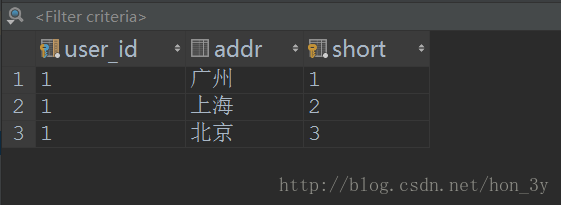
一对多和多对一
上面我们讲解了集合映射是怎么配置的,那集合装载的元素有没有可能是对象呢??而不是简单的String类型..那个就太多了!一般地,我们集合装载的都是对象,而不是简单的String,如果我们的装载在集合的数据有很多类型,那么String就不能用了!…
需求:部门与员工之间的关系
- 一个部门有多个员工; 【一对多】
- 多个员工,属于一个部门 【多对一】
设计数据库表
员工表应该使用一个外键来记住部门表。这样才可以维护员工和部门之间的关系

设计实体
部门实体要使用一个集合来记住所有的员工,员工要使用一个对象引用着部门

1
2
3
4
5
6
7
8
9
10
11
12
13
14
15
16
17
18
19
20
21
22
23
24
25
26
27
28
29
30
31
32
33
34
35
36
37
38
39
40
| package zhongfucheng.domain;
import java.util.HashSet;
import java.util.Set;
public class Dept {
private int id ;
private Set<Employee> set = new HashSet<>();
private String deptName;
public String getDeptName() {
return deptName;
}
public void setDeptName(String deptName) {
this.deptName = deptName;
}
public int getId() {
return id;
}
public void setId(int id) {
this.id = id;
}
public Set<Employee> getSet() {
return set;
}
public void setSet(Set<Employee> set) {
this.set = set;
}
}
|
1
2
3
4
5
6
7
8
9
10
11
12
13
14
15
16
17
18
19
20
21
22
23
24
25
26
27
28
29
30
31
32
33
34
35
36
37
38
39
40
41
42
43
44
45
| package zhongfucheng.domain;
public class Employee {
private int id;
private String empName;
private double salary;
private Dept dept;
public Dept getDept() {
return dept;
}
public void setDept(Dept dept) {
this.dept = dept;
}
public int getId() {
return id;
}
public void setId(int id) {
this.id = id;
}
public String getEmpName() {
return empName;
}
public void setEmpName(String empName) {
this.empName = empName;
}
public double getSalary() {
return salary;
}
public void setSalary(double salary) {
this.salary = salary;
}
}
|
映射分析
我们在写映射配置文件之前,分析一下怎么写。以部门映射配置文件为例…
现在使用了一个Set集合来维护与员工的关系,Set集合的类型是员工对象…因此在映射文件中需要以下几点
- 映射集合属性的名称(employees)
- 映射集合对应的数据表(employee)
- 对应的数据表的外键字段(dept_id)
- 集合中的元素类型(Employee)【通过这个类型,Hibernate就可以找到对应类型的映射文件,从而得到对应的信息!】

部门映射配置文件
1
2
3
4
5
6
7
8
9
10
11
12
13
14
15
16
17
18
19
20
21
22
23
24
25
26
27
28
29
30
| <?xml version="1.0"?>
<!DOCTYPE hibernate-mapping PUBLIC
"-//Hibernate/Hibernate Mapping DTD 3.0//EN"
"http://www.hibernate.org/dtd/hibernate-mapping-3.0.dtd">
<hibernate-mapping package="zhongfucheng.domain">
<class name="Dept" table="dept">
<id column="id" name="id">
<generator class="native">
</generator>
</id>
<property name="deptName" column="deptname"></property>
<set cascade="save-update" name="set" table="employee">
<key column="dept_no"></key>
<one-to-many class="Employee" ></one-to-many>
</set>
</class>
</hibernate-mapping>
|
员工映射配置文件
1
2
3
4
5
6
7
8
9
10
11
12
13
14
15
16
17
18
19
20
21
22
23
24
| <?xml version="1.0"?>
<!DOCTYPE hibernate-mapping PUBLIC
"-//Hibernate/Hibernate Mapping DTD 3.0//EN"
"http://www.hibernate.org/dtd/hibernate-mapping-3.0.dtd">
<hibernate-mapping package="zhongfucheng.domain">
<class name="Employee" table="employee">
<id column="id" name="id">
<generator class="native">
</generator>
</id>
<property name="empName" column="empName"></property>
<property name="salary" column="salary"></property>
<many-to-one name="dept" class="Dept" column="dept_no"></many-to-one>
</class>
</hibernate-mapping>
|
在“一”的一方测试
1
2
3
4
5
6
7
8
9
10
11
12
13
14
15
16
17
18
19
20
21
22
23
24
25
26
27
28
29
30
31
32
33
34
35
36
37
38
39
40
41
42
43
44
45
46
47
48
49
50
51
52
53
54
55
56
57
58
| package zhongfucheng.domain;
import org.hibernate.SessionFactory;
import org.hibernate.Transaction;
import org.hibernate.cfg.Configuration;
import org.hibernate.classic.Session;
public class App {
public static void main(String[] args) {
Dept dept = new Dept();
dept.setDeptName("开发部");
Employee zs = new Employee();
zs.setEmpName("张珊");
zs.setSalary(1111);
Employee ls = new Employee();
ls.setEmpName("李四");
ls.setSalary(2222);
dept.getSet().add(zs);
dept.getSet().add(ls);
Configuration configuration = new Configuration();
configuration.configure().addClass(Dept.class).addClass(Employee.class);
SessionFactory factory = configuration.buildSessionFactory();
Session session = factory.openSession();
Transaction transaction = session.getTransaction();
transaction.begin();
session.save(dept);
session.save(zs);
session.save(ls);
transaction.commit();
session.close();
}
}
|
Hibernate执行了5条SQL语句
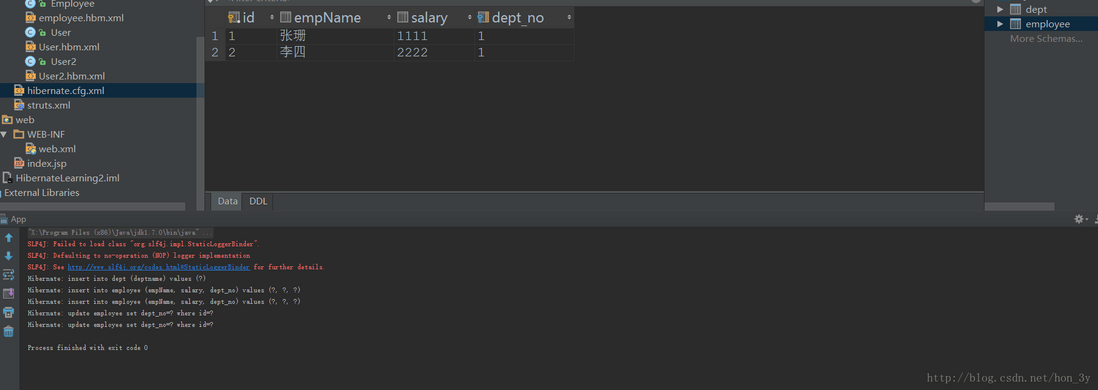
在“多”的一方测试
1
2
3
4
5
6
7
8
9
10
11
12
13
14
15
16
17
18
19
20
21
22
23
24
25
26
27
28
29
30
31
32
33
34
35
36
37
38
39
40
41
42
43
44
45
46
47
48
49
50
51
52
53
54
55
56
57
58
59
60
61
62
| package zhongfucheng.domain;
import org.hibernate.SessionFactory;
import org.hibernate.Transaction;
import org.hibernate.cfg.Configuration;
import org.hibernate.classic.Session;
public class App {
public static void main(String[] args) {
Dept dept = new Dept();
dept.setDeptName("开发部");
Employee zs = new Employee();
zs.setEmpName("张珊");
zs.setSalary(1111);
Employee ls = new Employee();
ls.setEmpName("李四");
ls.setSalary(2222);
zs.setDept(dept);
ls.setDept(dept);
Configuration configuration = new Configuration();
configuration.configure().addClass(Dept.class).addClass(Employee.class);
SessionFactory factory = configuration.buildSessionFactory();
Session session = factory.openSession();
Transaction transaction = session.getTransaction();
transaction.begin();
session.save(dept);
session.save(zs);
session.save(ls);
transaction.commit();
session.close();
}
}
|
Hibernate执行了3条SQL
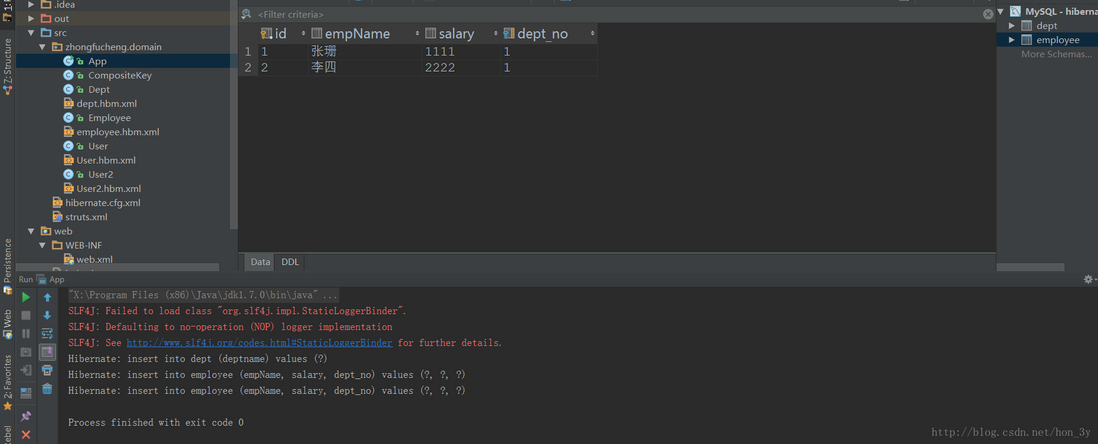
一对多和多对一总结
在一对多与多对一的关联关系中,保存数据最好的通过多的一方来维护关系,这样可以减少update语句的生成,从而提高hibernate的执行效率!
- 配置一对多与多对一, 这种叫“双向关联”
- 只配置一对多, 叫“单项一对多”
- 只配置多对一, 叫“单项多对一”
值得注意是:配置了哪一方,哪一方才有维护关联关系的权限!
- 当我在部门中不配置员工的关联关系了,那么在操作部门的时候就不能得到员工的数据了【也就是:在保存部门时,不能同时保存员工的数据】
多对多映射
需求:一个项目由多个员工开发,一个员工开发多个项目
设计数据库表
一般地,如果是多对多的映射,我们都会使用一张中间表来保存它们的关联关系….

设计实体
我们在设计实体的时候,一般是核心数据表对应一个JavaBean实体【中间表并不是核心数据表】,那么我们将会设计两个JavaBean对象

project.java
1
2
3
4
5
6
7
8
9
10
11
12
13
14
15
16
17
18
19
20
21
22
23
24
25
26
27
28
29
30
31
32
33
34
35
36
37
38
39
40
41
42
| package zhongfucheng.many2many;
import java.util.HashSet;
import java.util.Set;
public class Project {
private int projectId;
private String projectName;
private Set<Developer> developers = new HashSet<>();
public int getProjectId() {
return projectId;
}
public void setProjectId(int projectId) {
this.projectId = projectId;
}
public String getProjectName() {
return projectName;
}
public void setProjectName(String projectName) {
this.projectName = projectName;
}
public Set<Developer> getDevelopers() {
return developers;
}
public void setDevelopers(Set<Developer> developers) {
this.developers = developers;
}
}
|
developer.java
1
2
3
4
5
6
7
8
9
10
11
12
13
14
15
16
17
18
19
20
21
22
23
24
25
26
27
28
29
30
31
32
33
34
35
36
37
38
39
40
41
| package zhongfucheng.many2many;
import java.util.HashSet;
import java.util.Set;
public class Developer {
private int developerId;
private String developerName;
private Set<Project> projects = new HashSet<>();
public int getDeveloperId() {
return developerId;
}
public void setDeveloperId(int developerId) {
this.developerId = developerId;
}
public String getDeveloperName() {
return developerName;
}
public void setDeveloperName(String developerName) {
this.developerName = developerName;
}
public Set<Project> getProjects() {
return projects;
}
public void setProjects(Set<Project> projects) {
this.projects = projects;
}
}
|
映射配置文件
以项目映射文件为例:我们不急着写,首先来分析一下关键点……想要在多对多映射中产生正确的关联关系,下面几步必不可少:
- 配置映射集合的属性(developers)
- 映射集合对应的中间表(developer_project)
- 中间表的外键字段(project_id)
- 集合元素的类型(Developer)
- 中间表另外的外键字段(developer_id)
Project和Developer的映射文件都需要这几个关键步骤
Project映射文件
1
2
3
4
5
6
7
8
9
10
11
12
13
14
15
16
17
18
19
20
21
22
23
24
25
26
27
28
29
30
31
32
| <?xml version="1.0"?>
<!DOCTYPE hibernate-mapping PUBLIC
"-//Hibernate/Hibernate Mapping DTD 3.0//EN"
"http://www.hibernate.org/dtd/hibernate-mapping-3.0.dtd">
<hibernate-mapping package="zhongfucheng.many2many">
<class name="Project" table="Project">
<id name="projectId" column="projectId">
<generator class="native"></generator>
</id>
<property name="projectName" column="projectName"></property>
<set name="developers" table="developer_project">
<key column="project_id"></key>
<many-to-many column="developer_id" class="Developer"></many-to-many>
</set>
</class>
</hibernate-mapping>
|
Developer映射文件
1
2
3
4
5
6
7
8
9
10
11
12
13
14
15
16
17
18
19
20
21
22
23
24
25
26
27
28
29
30
31
32
| <?xml version="1.0"?>
<!DOCTYPE hibernate-mapping PUBLIC
"-//Hibernate/Hibernate Mapping DTD 3.0//EN"
"http://www.hibernate.org/dtd/hibernate-mapping-3.0.dtd">
<hibernate-mapping package="zhongfucheng.many2many">
<class name="Developer" table="Developer">
<id name="developerId" column="developerId">
<generator class="native"></generator>
</id>
<property name="developerName" column="developerName"></property>
<set name="projects" table="developer_project">
<key column="developer_id"></key>
<many-to-many column="project_id" class="Project"></many-to-many>
</set>
</class>
</hibernate-mapping>
|
测试
1
2
3
4
5
6
7
8
9
10
11
12
13
14
15
16
17
18
19
20
21
22
23
24
25
26
27
28
29
30
31
32
33
34
35
36
37
38
39
40
41
42
43
44
45
46
47
48
49
50
51
52
53
54
55
56
57
58
59
60
61
62
63
64
65
66
67
68
69
70
71
72
73
74
75
76
77
78
79
80
| package zhongfucheng.many2many;
import org.hibernate.SessionFactory;
import org.hibernate.Transaction;
import org.hibernate.cfg.Configuration;
import org.hibernate.classic.Session;
public class App2 {
public static void main(String[] args) {
Developer cj = new Developer();
Developer wc = new Developer();
Developer lz = new Developer();
Project ds = new Project();
Project oa = new Project();
cj.setDeveloperName("曹吉");
wc.setDeveloperName("王春");
lz.setDeveloperName("老张");
oa.setProjectName("OA系统");
ds.setProjectName("电商系统");
oa.getDevelopers().add(wc);
oa.getDevelopers().add(lz);
ds.getDevelopers().add(cj);
ds.getDevelopers().add(wc);
Configuration configuration = new Configuration();
configuration.configure().addClass(Developer.class).addClass(Project.class);
SessionFactory factory = configuration.buildSessionFactory();
Session session = factory.openSession();
Transaction transaction = session.getTransaction();
transaction.begin();
session.save(oa);
session.save(ds);
transaction.commit();
session.close();
}
}
|
执行了9条SQL语句,数据库中的记录也是正确的。
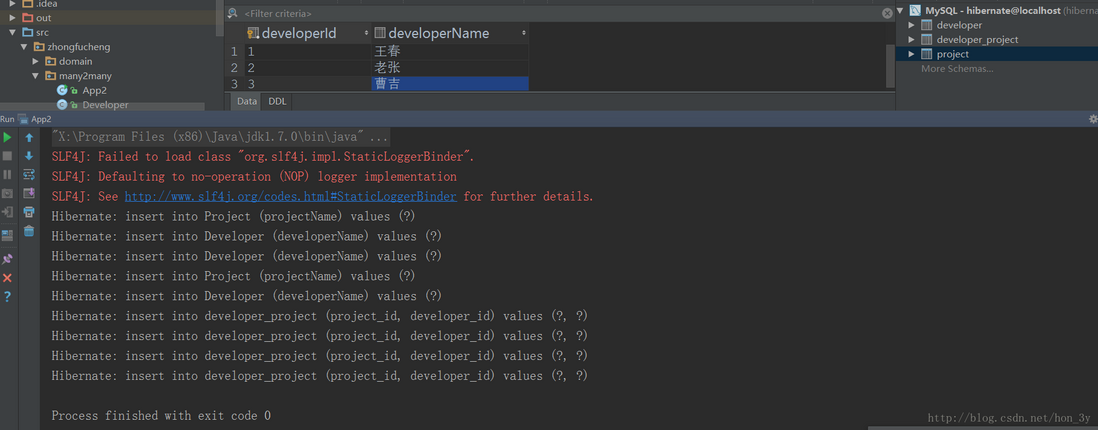
一对一的映射
需求:用户与身份证信息..一个用户对应一个身份证
数据库表设计
对于数据库表设计我们有两种方式
- 第一种:在身份证的数据表中设置一个外键来维护用户的关系,这个外键也应该是唯一的【一个用户对应一张身份证】
- 第二种:在身份证的数据表中使用主键+外键的方式来维护用户的关系。
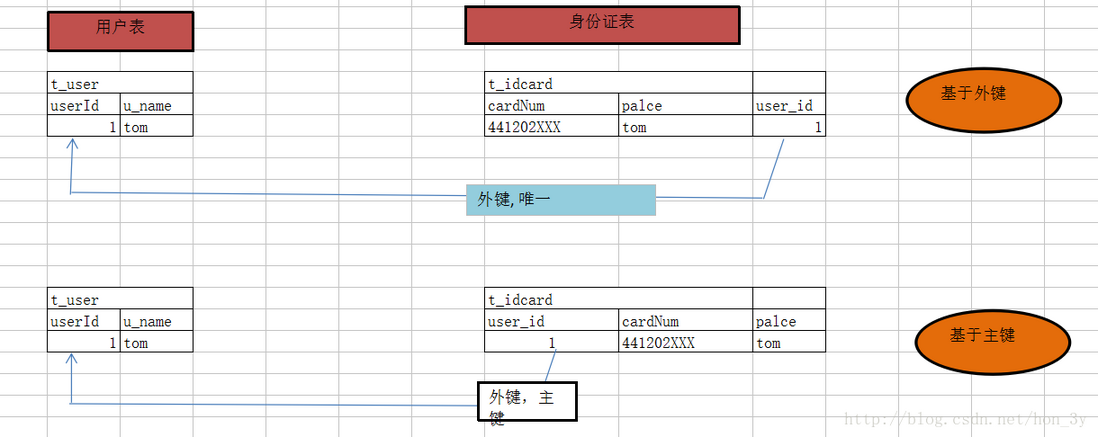
设计实体
idCard.java
1
2
3
4
5
6
7
8
9
10
11
12
13
14
15
16
17
18
19
20
21
22
23
24
25
26
27
28
29
30
31
32
33
34
35
36
37
| package zhongfucheng.one2one;
public class IdCard {
private int idCardId;
private String idCardName;
private User user ;
public int getIdCardId() {
return idCardId;
}
public void setIdCardId(int idCardId) {
this.idCardId = idCardId;
}
public String getIdCardName() {
return idCardName;
}
public void setIdCardName(String idCardName) {
this.idCardName = idCardName;
}
public User getUser() {
return user;
}
public void setUser(User user) {
this.user = user;
}
}
|
User.java
1
2
3
4
5
6
7
8
9
10
11
12
13
14
15
16
17
18
19
20
21
22
23
24
25
26
27
28
29
30
31
32
33
34
35
36
37
| package zhongfucheng.one2one;
public class User {
private int userId;
private String userName;
private IdCard idCard ;
public int getUserId() {
return userId;
}
public void setUserId(int userId) {
this.userId = userId;
}
public String getUserName() {
return userName;
}
public void setUserName(String userName) {
this.userName = userName;
}
public IdCard getIdCard() {
return idCard;
}
public void setIdCard(IdCard idCard) {
this.idCard = idCard;
}
}
|
第一种方式映射文件
我们有两种方式来设计数据库中的表实现一对一的关系,首先我们来挑比较熟悉的外键方式来写映射文件
user映射文件
1
2
3
4
5
6
7
8
9
10
11
12
13
14
15
16
17
18
19
20
21
22
23
24
25
26
27
| <?xml version="1.0"?>
<!DOCTYPE hibernate-mapping PUBLIC
"-//Hibernate/Hibernate Mapping DTD 3.0//EN"
"http://www.hibernate.org/dtd/hibernate-mapping-3.0.dtd">
<hibernate-mapping package="zhongfucheng.one2one">
<class name="User" table="User">
<id name="userId" column="userId">
<generator class="native"></generator>
</id>
<property name="userName" column="userName"></property>
<one-to-one name="idCard" class="IdCard"></one-to-one>
</class>
</hibernate-mapping>
|
idCard映射文件
1
2
3
4
5
6
7
8
9
10
11
12
13
14
15
16
17
18
19
20
21
22
23
24
25
26
27
28
29
30
| <?xml version="1.0"?>
<!DOCTYPE hibernate-mapping PUBLIC
"-//Hibernate/Hibernate Mapping DTD 3.0//EN"
"http://www.hibernate.org/dtd/hibernate-mapping-3.0.dtd">
<hibernate-mapping package="zhongfucheng.one2one">
<class name="IdCard" table="IdCard">
<id name="idCardId" column="idCardId">
<generator class="native"></generator>
</id>
<property name="idCardName" column="idCardName"></property>
<many-to-one name="user" column="user_id" class="User" unique="true" cascade="save-update"></many-to-one>
</class>
</hibernate-mapping>
|
测试
要使用IdCart来维护User的关联关系。
- 如果使用User来维护idCart的关联关系,idCart的外键列是为NULL的,因为重头到尾我们都没有给它赋值
- 而使用IdCart来维护User,是外键值是根据User的主键id来生成的
1
2
3
4
5
6
7
8
9
10
11
12
13
14
15
16
17
18
19
20
21
22
23
24
25
26
27
28
29
30
31
32
33
34
35
36
37
38
39
40
41
42
43
44
45
46
47
48
49
50
51
52
| package zhongfucheng.one2one;
import org.hibernate.SessionFactory;
import org.hibernate.Transaction;
import org.hibernate.cfg.Configuration;
import org.hibernate.classic.Session;
public class App3 {
public static void main(String[] args) {
User user = new User();
IdCard idCard = new IdCard();
user.setUserName("你好");
idCard.setIdCardName("身份证001");
idCard.setUser(user);
Configuration configuration = new Configuration();
configuration.configure().addClass(User.class).addClass(IdCard.class);
SessionFactory factory = configuration.buildSessionFactory();
Session session = factory.openSession();
Transaction transaction = session.getTransaction();
transaction.begin();
session.save(idCard);
transaction.commit();
session.close();
}
}
|
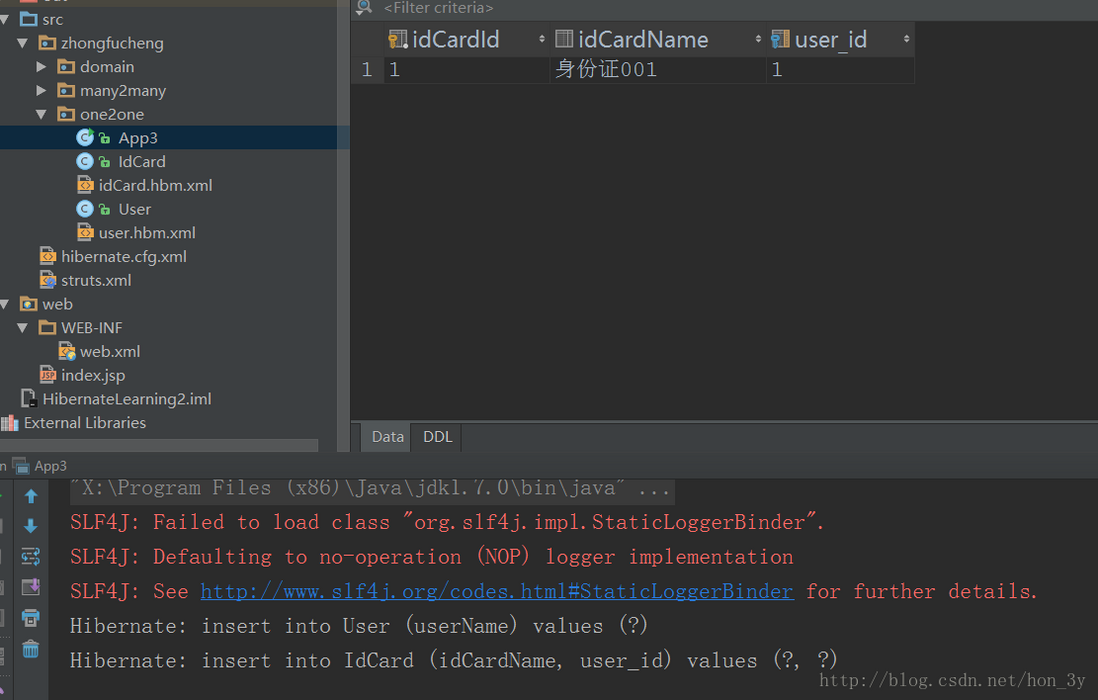
第二种方式映射文件
因为IdCart使用userId作为了主键,因此需要在JavaBean中配置多一个属性UserId…其他的都不用变
1
2
3
4
5
6
7
8
| private int userId;
public int getUserId() {
return userId;
}
public void setUserId(int userId) {
this.userId = userId;
}
|
在Hibernate入门篇讲解配置的时候,在generator节点下还有一个属性没有讲解,也就是foreign属性…现在来填坑了..
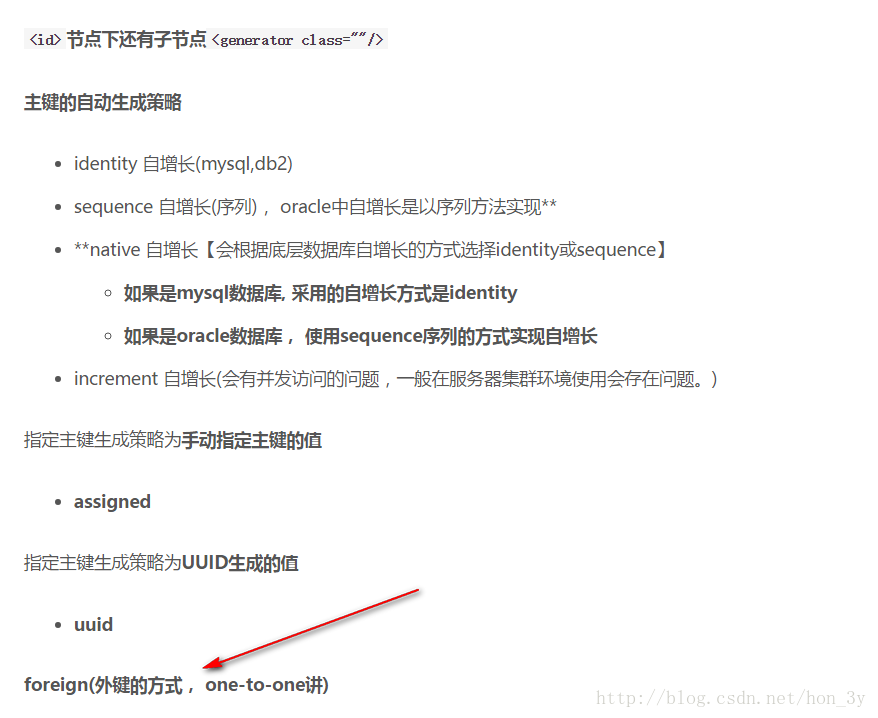
idCard映射文件
idCart的映射文件主要在于:将主键也映射成外键来使用,这就需要用到foreign属性值了
使用<one-to-one>标签来配置基于主键的映射
1
2
3
4
5
6
7
8
9
10
11
12
13
14
15
16
17
18
19
20
21
22
23
24
25
26
27
28
29
30
31
32
33
34
35
36
37
38
39
| <?xml version="1.0"?>
<!DOCTYPE hibernate-mapping PUBLIC
"-//Hibernate/Hibernate Mapping DTD 3.0//EN"
"http://www.hibernate.org/dtd/hibernate-mapping-3.0.dtd">
<hibernate-mapping package="zhongfucheng.one2one2.one2one">
<class name="IdCard" table="IdCard">
<id name="userId" column="userId">
<generator class="foreign">
<param name="property">user</param>
</generator>
</id>
<property name="idCardName" column="idCardName"></property>
<property name="idCardId" column="idCartId"></property>
<one-to-one name="user" class="User" constrained="true"></one-to-one>
</class>
</hibernate-mapping>
|
user映射文件
1
2
3
4
5
6
7
8
9
10
11
12
13
14
15
16
17
18
19
20
21
22
23
24
25
26
27
| <?xml version="1.0"?>
<!DOCTYPE hibernate-mapping PUBLIC
"-//Hibernate/Hibernate Mapping DTD 3.0//EN"
"http://www.hibernate.org/dtd/hibernate-mapping-3.0.dtd">
<hibernate-mapping package="zhongfucheng.one2one2.one2one">
<class name="User" table="User">
<id name="userId" column="userId">
<generator class="native"></generator>
</id>
<property name="userName" column="userName"></property>
<one-to-one name="idCard" class="IdCard"></one-to-one>
</class>
</hibernate-mapping>
|
测试
1
2
3
4
5
6
7
8
9
10
11
12
13
14
15
16
17
18
19
20
21
22
23
24
25
26
27
28
29
30
31
32
33
34
35
36
37
38
39
40
41
42
43
44
45
46
47
48
49
50
51
52
53
| package zhongfucheng.one2one2.one2one;
import org.hibernate.SessionFactory;
import org.hibernate.Transaction;
import org.hibernate.cfg.Configuration;
import org.hibernate.classic.Session;
public class App4 {
public static void main(String[] args) {
User user = new User();
IdCard idCard = new IdCard();
user.setUserName("你好3");
idCard.setIdCardName("身份证003");
idCard.setIdCardId(4235);
idCard.setUser(user);
Configuration configuration = new Configuration();
configuration.configure().addClass(User.class).addClass(IdCard.class);
SessionFactory factory = configuration.buildSessionFactory();
Session session = factory.openSession();
Transaction transaction = session.getTransaction();
transaction.begin();
session.save(idCard);
transaction.commit();
session.close();
}
}
|
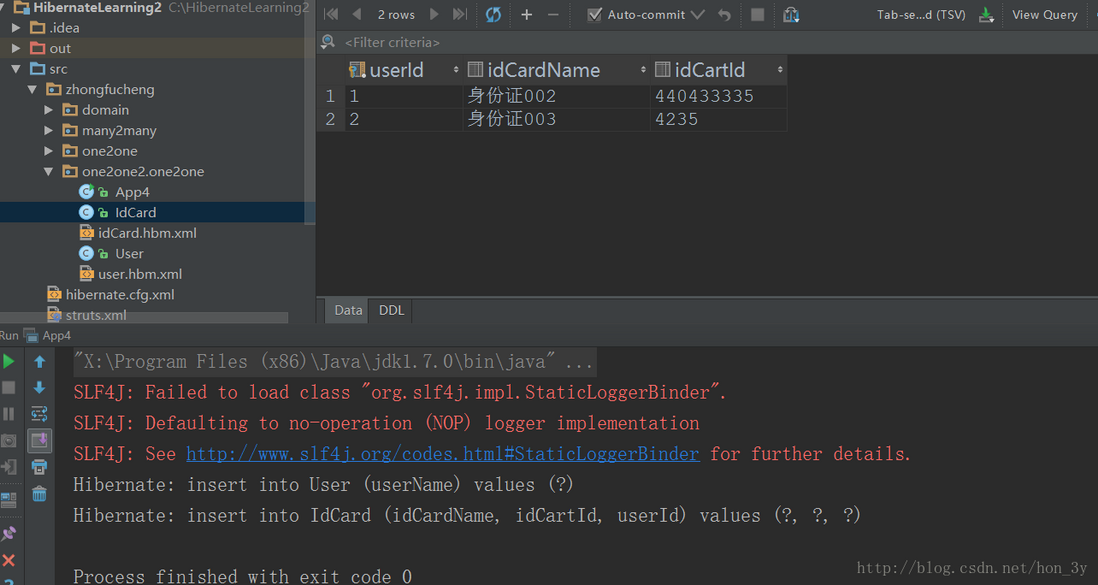
组件映射
Java主要的类主要有两种方式
- 组合关系,组合关系对应的就是组件映射
- 继承关系,继承关系对应的就是继承映射
组件映射实际上就是将组合关系的数据映射成一张表,组件类和被包含的组件类映射成一张表
有的时候,两个类的关系明显不是继承关系,但两个类的亲密程度很高,在一个类里边需要用到另外一个类…那么就在类中定义一个变量来维护另一个类的关系,这种就叫组合关系!
需求:汽车和轮子。汽车需要用到轮子,但是轮子的爸爸不可能是汽车吧?
设计数据库
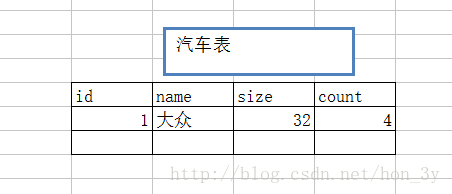
设计实体
Wheel.java
1
2
3
4
5
6
7
8
9
10
11
12
13
14
15
16
17
18
19
20
21
| public class Wheel {
private int count;
private int size;
public int getCount() {
return count;
}
public void setCount(int count) {
this.count = count;
}
public int getSize() {
return size;
}
public void setSize(int size) {
this.size = size;
}
}
|
Car.java,使用变量维护Wheel
1
2
3
4
5
6
7
8
9
10
11
12
13
14
15
16
17
18
19
20
21
22
23
24
25
26
27
28
29
30
31
32
33
34
35
| package zhongfucheng.aa;
public class Car {
private int id;
private String name;
private Wheel wheel;
public Wheel getWheel() {
return wheel;
}
public void setWheel(Wheel wheel) {
this.wheel = wheel;
}
public int getId() {
return id;
}
public void setId(int id) {
this.id = id;
}
public String getName() {
return name;
}
public void setName(String name) {
this.name = name;
}
}
|
映射表
**使用了一个新标签<component>**,组件映射标签。
1
2
3
4
5
6
7
8
9
10
11
12
13
14
15
16
17
18
19
20
21
22
23
24
25
26
27
28
29
| <?xml version="1.0"?>
<!DOCTYPE hibernate-mapping PUBLIC
"-//Hibernate/Hibernate Mapping DTD 3.0//EN"
"http://www.hibernate.org/dtd/hibernate-mapping-3.0.dtd">
<hibernate-mapping package="zhongfucheng.aa" >
<class name="Car" table="Car" >
<id name="id" column="id">
<generator class="native"></generator>
</id>
<property name="name" column="name" ></property>
<component name="wheel">
<property name="count"></property>
<property name="size"></property>
</component>
</class>
</hibernate-mapping>
|
测试
1
2
3
4
5
6
7
8
9
10
11
12
13
14
15
16
17
18
19
20
21
22
23
24
25
26
27
28
29
30
31
32
33
34
35
36
37
38
39
40
41
42
43
44
45
46
47
48
49
50
51
52
53
54
| package zhongfucheng.aa;
import org.hibernate.SessionFactory;
import org.hibernate.Transaction;
import org.hibernate.cfg.Configuration;
import org.hibernate.classic.Session;
public class App5 {
public static void main(String[] args) {
Wheel wheel = new Wheel();
Car car = new Car();
wheel.setCount(43);
wheel.setSize(22);
car.setName("宝马");
car.setWheel(wheel);
Configuration configuration = new Configuration();
configuration.configure().addClass(Car.class);
SessionFactory factory = configuration.buildSessionFactory();
Session session = factory.openSession();
Transaction transaction = session.getTransaction();
transaction.begin();
session.save(car);
transaction.commit();
session.close();
}
}
|
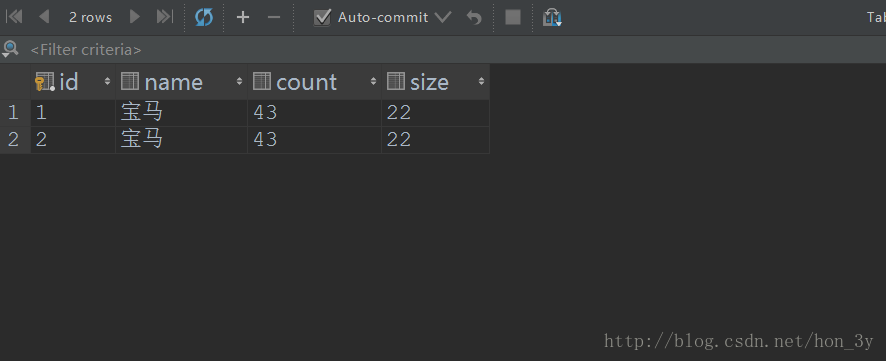
传统方式继承
需求:动物、猫、猴子。猫继承着动物
传统方式继承的特点就是:有多少个子类就写多少个配置文件.
表结构
我们的表应该是这样的:id和name从Animal中继承,catchMouse是子类的具体行为。
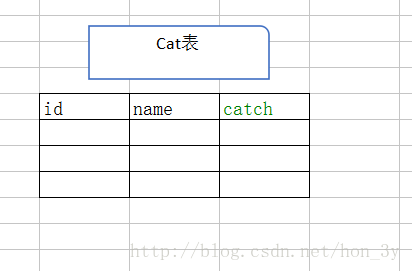
实体
Animal.java
1
2
3
4
5
6
7
8
9
10
11
12
13
14
15
16
17
18
19
20
21
22
23
| package zhongfucheng.aa;
public abstract class Animal {
private int id;
private String name;
public int getId() {
return id;
}
public void setId(int id) {
this.id = id;
}
public String getName() {
return name;
}
public void setName(String name) {
this.name = name;
}
}
|
Cat.java继承着Animail
1
2
3
4
5
6
7
8
9
10
11
12
13
14
15
| package zhongfucheng.aa;
public class Cat extends Animal{
private String catchMouse;
public String getCatchMouse() {
return catchMouse;
}
public void setCatchMouse(String catchMouse) {
this.catchMouse = catchMouse;
}
}
|
映射文件
简单继承的映射文件很好写,在属性上,直接写父类的属性就可以了。
但是也有致命的缺点:如果子类有很多,就需要写很多的配置文件
1
2
3
4
5
6
7
8
9
10
11
12
13
14
15
16
17
18
19
20
21
22
23
24
25
| <?xml version="1.0"?>
<!DOCTYPE hibernate-mapping PUBLIC
"-//Hibernate/Hibernate Mapping DTD 3.0//EN"
"http://www.hibernate.org/dtd/hibernate-mapping-3.0.dtd">
<hibernate-mapping package="zhongfucheng.aa" >
<class name="Cat" table="cat" >
<id name="id" column="id">
<generator class="native"></generator>
</id>
<property name="name" column="name" ></property>
<property name="catchMouse" column="catchMouse" ></property>
</class>
</hibernate-mapping>
|
测试
1
2
3
4
5
6
7
8
9
10
11
12
13
14
15
16
17
18
19
20
21
22
23
24
25
26
27
28
29
30
31
32
33
34
35
36
37
38
39
40
41
42
43
44
45
46
47
48
49
50
51
| package zhongfucheng.aa;
import org.hibernate.SessionFactory;
import org.hibernate.Transaction;
import org.hibernate.cfg.Configuration;
import org.hibernate.classic.Session;
public class App5 {
public static void main(String[] args) {
Cat cat = new Cat();
cat.setName("大花猫");
cat.setCatchMouse("捉大老鼠");
Configuration configuration = new Configuration();
configuration.configure().addClass(Cat.class);
SessionFactory factory = configuration.buildSessionFactory();
Session session = factory.openSession();
Transaction transaction = session.getTransaction();
transaction.begin();
session.save(cat);
transaction.commit();
session.close();
}
}
|
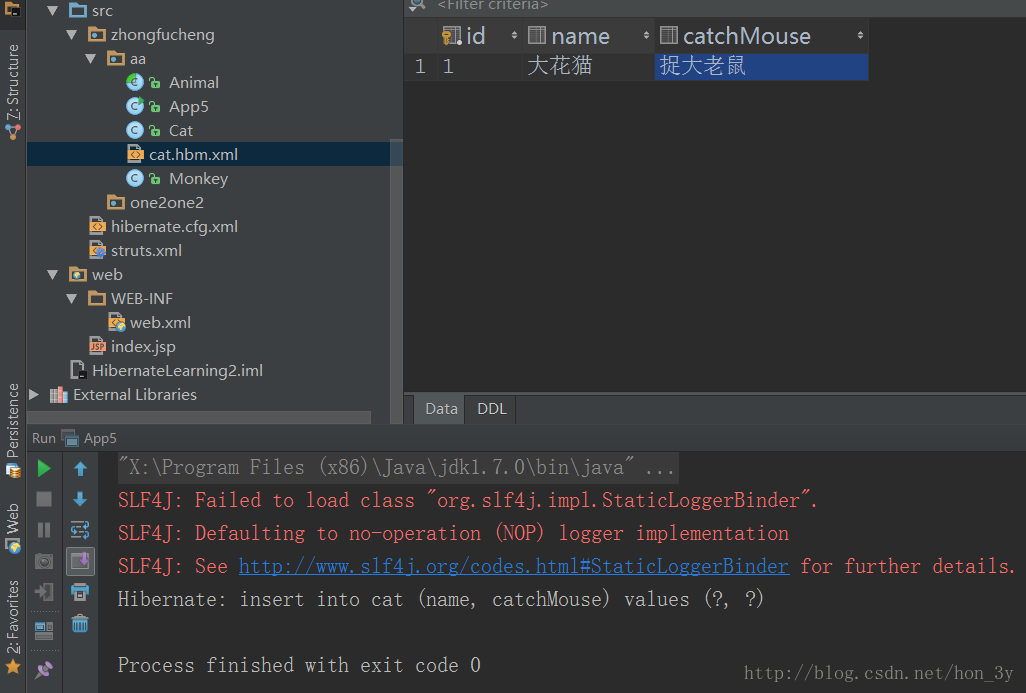
把所有子类映射成一张表
前面我们采用的是:每个子类都需要写成一个配置文件,映射成一张表…
如果子类的结构很简单,只比父类多几个属性。就像上面的例子…我们可以将所有的子类都映射成一张表中
但是呢,这样是不符合数据库设计规范的…..因为表中的数据**可能是猫,可能是猴子…**这明显是不合适的…
由于表中可能存在猫,存在猴子,为了区分是什么类型的。我们需要使用鉴别器
我们了解一下…
数据表
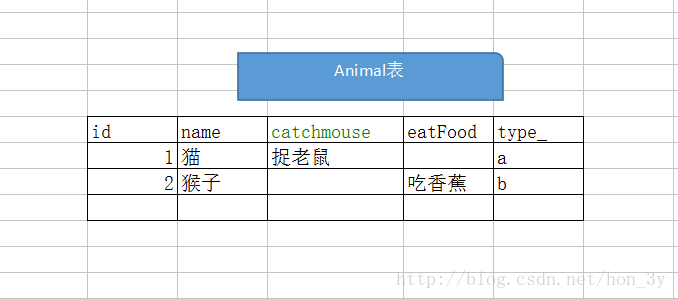
实体
实体和上面雷同,只多了一个猴子的实体表
Monkey.java
1
2
3
4
5
6
7
8
9
10
11
12
13
14
| public class Monkey extends Animal {
private String eatBanana;
public String getEatBanana() {
return eatBanana;
}
public void setEatBanana(String eatBanana) {
this.eatBanana = eatBanana;
}
}
|
映射文件
使用了subClass这个节点和鉴别器
1
2
3
4
5
6
7
8
9
10
11
12
13
14
15
16
17
18
19
20
21
22
23
24
25
26
27
28
29
30
31
32
33
34
35
36
37
38
39
40
41
42
43
| <?xml version="1.0"?>
<!DOCTYPE hibernate-mapping PUBLIC
"-//Hibernate/Hibernate Mapping DTD 3.0//EN"
"http://www.hibernate.org/dtd/hibernate-mapping-3.0.dtd">
<hibernate-mapping package="cn.itcast.e_extends2">
<class name="Animal" table="t_animal">
<id name="id">
<generator class="native"></generator>
</id>
<discriminator column="type_"></discriminator>
<property name="name"></property>
<subclass name="Cat" discriminator-value="cat_">
<property name="catchMouse"></property>
</subclass>
<subclass name="Monkey" discriminator-value="monkey_">
<property name="eatBanana"></property>
</subclass>
</class>
</hibernate-mapping>
|
测试
加载的是Animal父类的映射文件。保存的是cat和monkey。
1
2
3
4
5
6
7
8
9
10
11
12
13
14
15
16
17
18
19
20
21
22
23
24
25
26
27
28
29
30
31
32
33
34
35
36
37
38
39
40
41
42
43
44
45
46
47
48
49
50
51
| package zhongfucheng.aa;
import org.hibernate.SessionFactory;
import org.hibernate.Transaction;
import org.hibernate.cfg.Configuration;
import org.hibernate.classic.Session;
public class App5 {
public static void main(String[] args) {
Cat cat = new Cat();
Monkey monkey = new Monkey();
cat.setName("大花猫");
cat.setCatchMouse("小老鼠");
monkey.setEatBanana("吃香蕉");
monkey.setName("大猴子");
Configuration configuration = new Configuration();
configuration.configure().addClass(Animal.class);
SessionFactory factory = configuration.buildSessionFactory();
Session session = factory.openSession();
Transaction transaction = session.getTransaction();
transaction.begin();
session.save(cat);
session.save(monkey);
transaction.commit();
session.close();
}
}
|
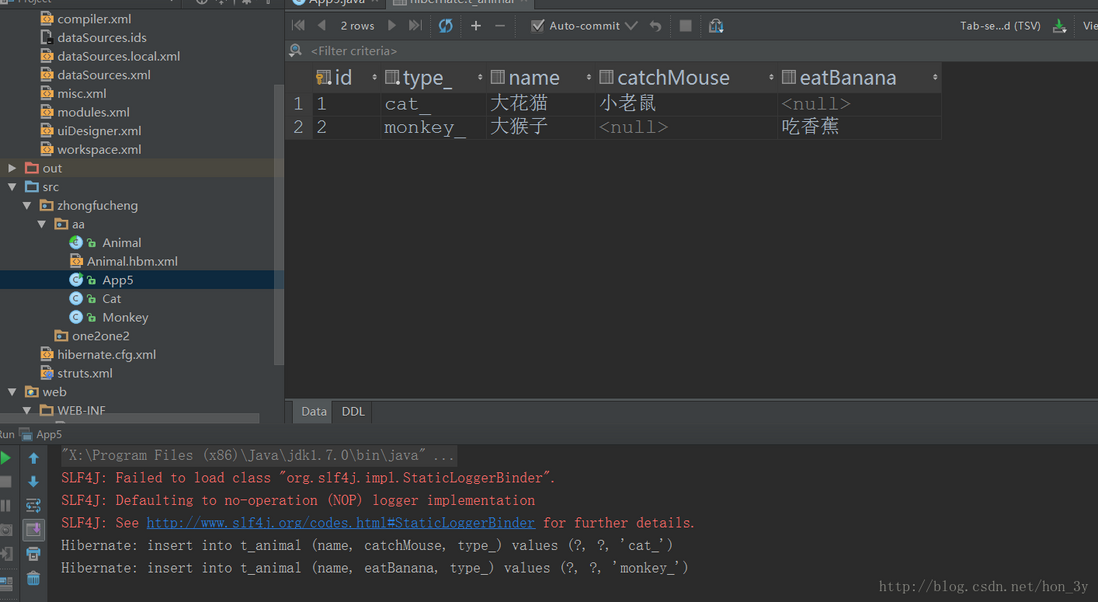
每个类映射一张表(3张表)
父类和子类都各对应一张表。那么就有三张表了
这种结构看起来是完全面向对象,但是表之间的结构会很复杂,插入一条子类的信息,需要两条SQL
数据表设计

映射文件
使用到了<joined-subclass >这个节点
1
2
3
4
5
6
7
8
9
10
11
12
13
14
15
16
17
18
19
20
21
22
23
24
25
26
27
28
29
30
31
32
33
34
35
36
37
38
39
| <?xml version="1.0"?>
<!DOCTYPE hibernate-mapping PUBLIC
"-//Hibernate/Hibernate Mapping DTD 3.0//EN"
"http://www.hibernate.org/dtd/hibernate-mapping-3.0.dtd">
<hibernate-mapping package="zhongfucheng.aa">
<class name="Animal" table="t_animal">
<id name="id">
<generator class="native"></generator>
</id>
<property name="name"></property>
<joined-subclass name="Cat" table="cat_">
<key column="animal_id"></key>
<property name="catchMouse"></property>
</joined-subclass>
<joined-subclass name="Monkey" table="monkey_">
<key column="animal_id"></key>
<property name="eatBanana"></property>
</joined-subclass>
</class>
</hibernate-mapping>
|
测试
1
2
3
4
5
6
7
8
9
10
11
12
13
14
15
16
17
18
19
20
21
22
23
24
25
26
27
28
29
30
31
32
33
34
35
36
37
38
39
40
41
42
43
44
45
46
47
48
49
50
51
| package zhongfucheng.aa;
import org.hibernate.SessionFactory;
import org.hibernate.Transaction;
import org.hibernate.cfg.Configuration;
import org.hibernate.classic.Session;
public class App5 {
public static void main(String[] args) {
Cat cat = new Cat();
Monkey monkey = new Monkey();
cat.setName("大花猫");
cat.setCatchMouse("小老鼠");
monkey.setEatBanana("吃香蕉");
monkey.setName("大猴子");
Configuration configuration = new Configuration();
configuration.configure().addClass(Animal.class);
SessionFactory factory = configuration.buildSessionFactory();
Session session = factory.openSession();
Transaction transaction = session.getTransaction();
transaction.begin();
session.save(cat);
session.save(monkey);
transaction.commit();
session.close();
}
}
|
每保存一个子类对象需要两条SQL语句!
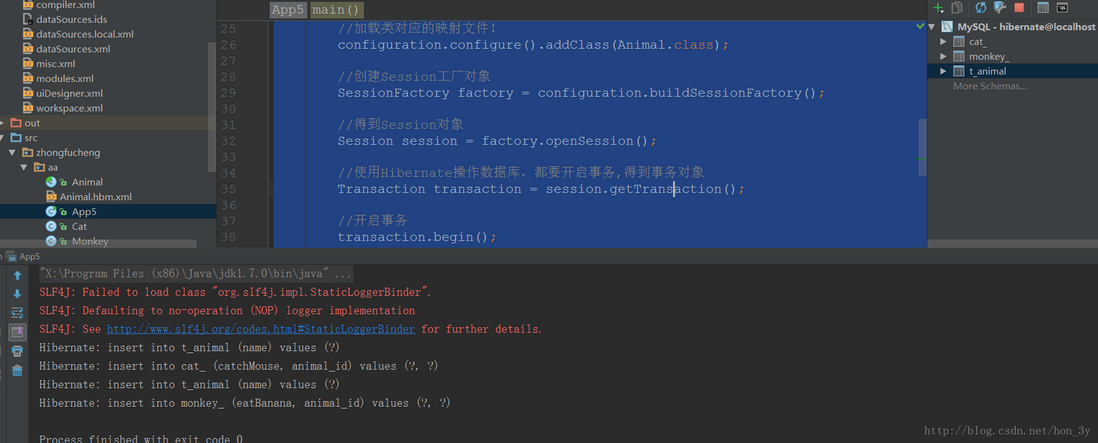
(推荐)每个子类映射一张表, 父类不对应表(2张表)
- 使用过了一张表保存所有子类的数据,这不符合数据库设计规范
- 每个子类、父类都拥有一张表..表结构太过于繁琐..添加信息时,过多的SQL
我们即将使用的是:每个子类映射成一张表,父类不对应表…这和我们传统方式继承是一样的。只不过在hbm.xml文件中使用了<union-subclass>这个节点,由于有了这个节点,我们就不需要每个子类都写一个配置文件了。
数据库表设计
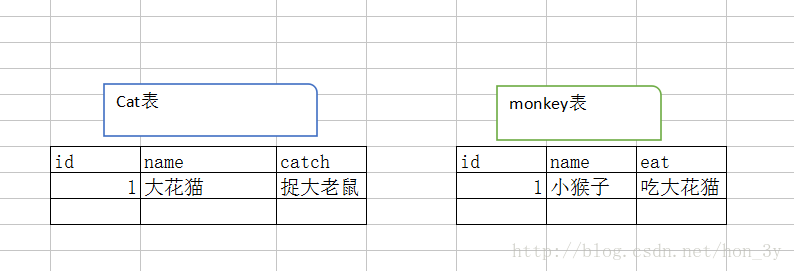
映射文件
- 想要父类不映射成数据库表,只要在class中配置为abstract即可
- 使用了union-subclass节点,主键就不能采用自动增长策略了。我们改成UUID即可。当然啦,对应的实体id类型要改成String
1
2
3
4
5
6
7
8
9
10
11
12
13
14
15
16
17
18
19
20
21
22
23
24
25
26
27
28
29
30
31
32
33
34
35
36
37
38
39
40
41
42
43
| <?xml version="1.0"?>
<!DOCTYPE hibernate-mapping PUBLIC
"-//Hibernate/Hibernate Mapping DTD 3.0//EN"
"http://www.hibernate.org/dtd/hibernate-mapping-3.0.dtd">
<hibernate-mapping package="zhongfucheng.aa">
<class name="Animal" abstract="true">
<id name="id">
<generator class="uuid"></generator>
</id>
<property name="name"></property>
<union-subclass name="Cat" table="cat_">
<property name="catchMouse"></property>
</union-subclass>
<union-subclass name="Monkey" table="monkey_">
<property name="eatBanana"></property>
</union-subclass>
</class>
</hibernate-mapping>
|
测试
1
2
3
4
5
6
7
8
9
10
11
12
13
14
15
16
17
18
19
20
21
22
23
24
25
26
27
28
29
30
31
32
33
34
35
36
37
38
39
40
41
42
43
44
45
46
47
48
49
50
51
| package zhongfucheng.aa;
import org.hibernate.SessionFactory;
import org.hibernate.Transaction;
import org.hibernate.cfg.Configuration;
import org.hibernate.classic.Session;
public class App5 {
public static void main(String[] args) {
Cat cat = new Cat();
Monkey monkey = new Monkey();
cat.setName("大花猫");
cat.setCatchMouse("小老鼠");
monkey.setEatBanana("吃香蕉");
monkey.setName("大猴子");
Configuration configuration = new Configuration();
configuration.configure().addClass(Animal.class);
SessionFactory factory = configuration.buildSessionFactory();
Session session = factory.openSession();
Transaction transaction = session.getTransaction();
transaction.begin();
session.save(cat);
session.save(monkey);
transaction.commit();
session.close();
}
}
|
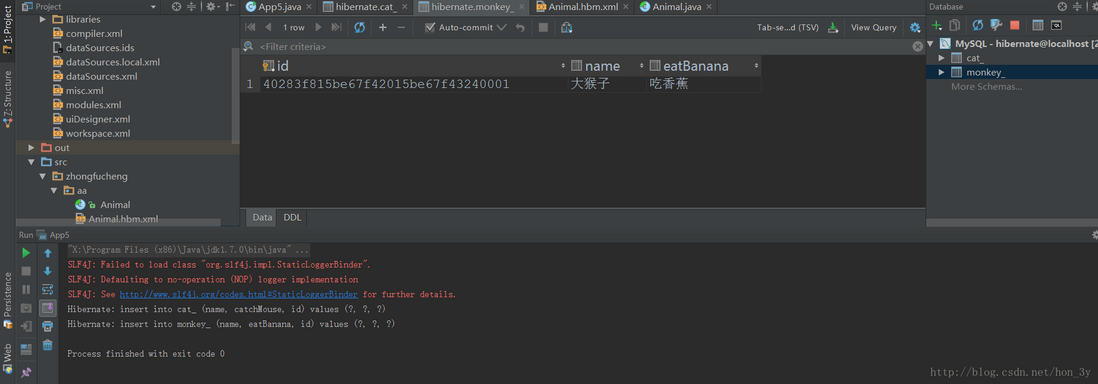
组件映射和继承映射总结
由于我们的传统继承映射每个子类都对应一个配置文件,这样十分麻烦。因此**.hbm.xml就给出了几个节点供我们使用**,分别有以下的情况:
- 子类父类共有一张表
subclass
- 子类、父类都有自己的表
joined-subclass,那么就是三张表
- 表的结构太过繁琐
- 插入数据时要生成SQL至少就要两条
- 子类拥有自己的表、父类不对应表【推荐】
union-subclass
- 父类不对应表要使用abstract来修饰
- 主键的id不能使用自增长策略,修改成UUID就好了。对应的JavaBean的id设置成String就好
























